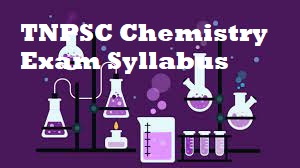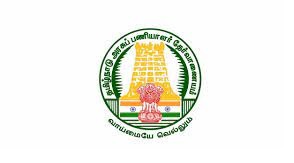TNPSC Chemistry Exam Syllabus : Tamil Nadu Public Service Commission
Organisation : Tamil Nadu Public Service Commission (TNPSC)
Exam Name : TNPSC Chemistry Examination
Standard : PG Degree Standard
Subject Code : 244
Announcement : TNPSC Chemistry Exam Syllabus
Website : https://www.tnpsc.gov.in/English/new_syllabus.html
TNPSC Chemistry Exam Syllabus
TNPSC Chemistry Exam Syllabus are given below,
Related / Similar Syllabus : TNPSC Fisheries Science Exam Syllabus

UNIT 1. Reaction Kinetics:
Rate laws – rates constant for first, second, third and zero order reaction – Half life period – Arrehenius theory – collission theory – Absolute reaction rate theory – ionic reaction – salt effect – catalysis – Laws of photo chemistry, quantum efficiency – photo physical processes of electronic excited molecules. Green Chemistry – reactions and reagents
Chemical Equilibrium:
Partial molar quantities, gibbs – Duhem equation, Equilibrium constant – temperature dependence of equilibrium constant – phase rule and its applications to two and three components systems.
UNIT 2. Solid State:
crystal systems – designation of crystal faces, lattice structure and unit cell – law of rational indices – Bragg’s law and x rays diffractrion by crystals – schottky and Frenkel defects – Electrical properties – Insulators and semiconductors – band theory of solids –Superconductors – nano materials preparations and properties.
Electrochemistry:
Types of Reversible electrodes – Nearnst equation – calculation of thermo dynamic quantities of cell reactions – overpotential and hydrogen over voltage – Determination of pka of acids by potentiometric methods – Kohlarash’s law – ostwald’s dilution law – Debye – Huckel onsager equation for Strong electrolytes – (no derivation required) – Primary and Secondary fuelcells – corrosion and prevention – drycells and storage batteries
UNIT 3. Structure & Bonding:
Electronic configuration of atoms, Term symbols and periodic properties o f elements, Ionic radii, ionisation potential electron affinity, electronegativity, concept of Hybridization, molecular orbitals and electronic configuration of homonuclear and heter nuclear diatomic molecules, shapes of polyatomic molecules VSEPR theory, symmetry elements and point groups for simple molecules, Bond lengths, Bond angles, bond order and bond energies Types of chemical bond (weak and strong) inter molecular forces, structure of simple and covalent bonds – covalent character in ionic bond and partial ionic character – lattice energy.
Acids and Bases:
Bronsted and Lewis acids and bases – pH and pKa acid – base concept in non – aqueous media – HSAB concept – Buffer Solutions. Redox Reactions:- Oxidation numbers, Redox potential, Electro chemical series – application of EMF measurements – Redox indicators.
Chemistry of Non – transition elements:
General characteristics, structure and reaction of simple compounds – boranes – silicates Oxoacids of N,P,S and halagens – xenoncompounds – inter halegens, Pseudehalides and noble gas compounds – metal clusters – S,N ring and chain compounds – inorganic Polymers such as silicones, Borazines and phosphonitrilic compounds. IUPAC Nomenclature of simple organic and Inorganic compounds.
UNIT 4. Organic Reaction Mechanism:
General methods (Kinetic and non Kinetic) of study of reaction mechanisms Methods of determining reaction mechanism. – isotopic labelling SN1, SN2 mechanisms – addition substitution, elimination and rearrangements -free radical mechanism – aromatic substitution – and stability of reactive intermediate – Polar effects – Hammett’s equation and it modification.
Chemistry of important organic reaction – Aldol condensation – Claisen condensation – perkin reactions – cannizaro reaction – Fridel craft reaction – Favorski reaction – Strok enamine reaction – Michael addition – Baeyer – villigner reaction – Chichibabin reaction – Asymmetric synthesis pericyclic reactions – classification and examples – woodward and Hoffmann rules. – use of OsO4, NBS, diborane, NaBH4, LiAlH4 in organic Synthosise.

Download Syllabus
TNPSC Chemistry Exam Syllabus Link:
http://www.syllabus.gen.in/uploads/pdf2022/2900-syllabus.pdf